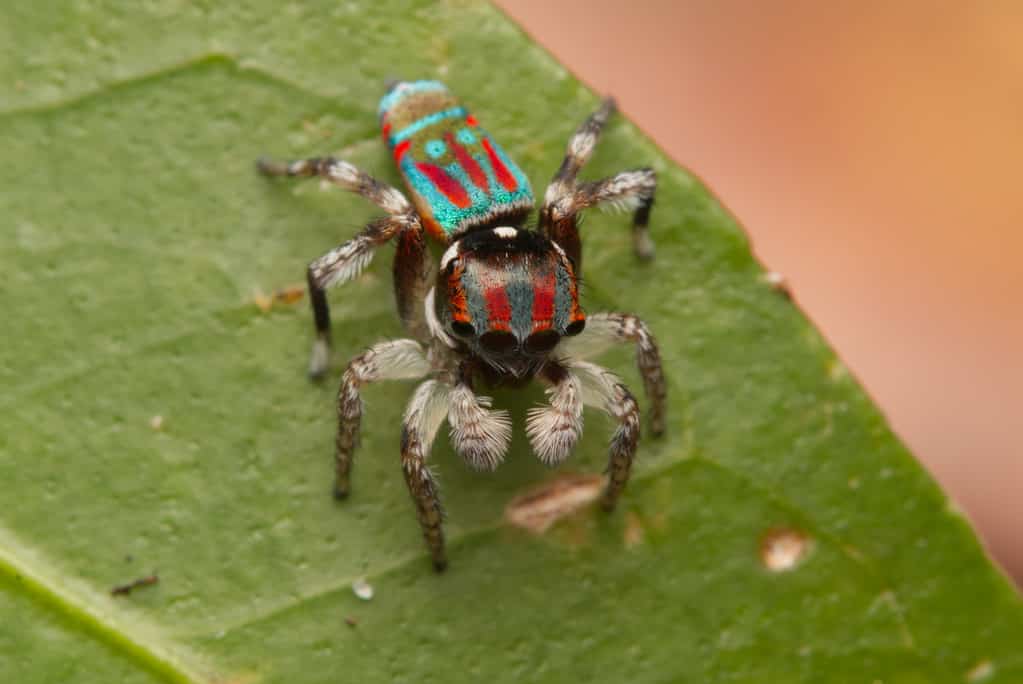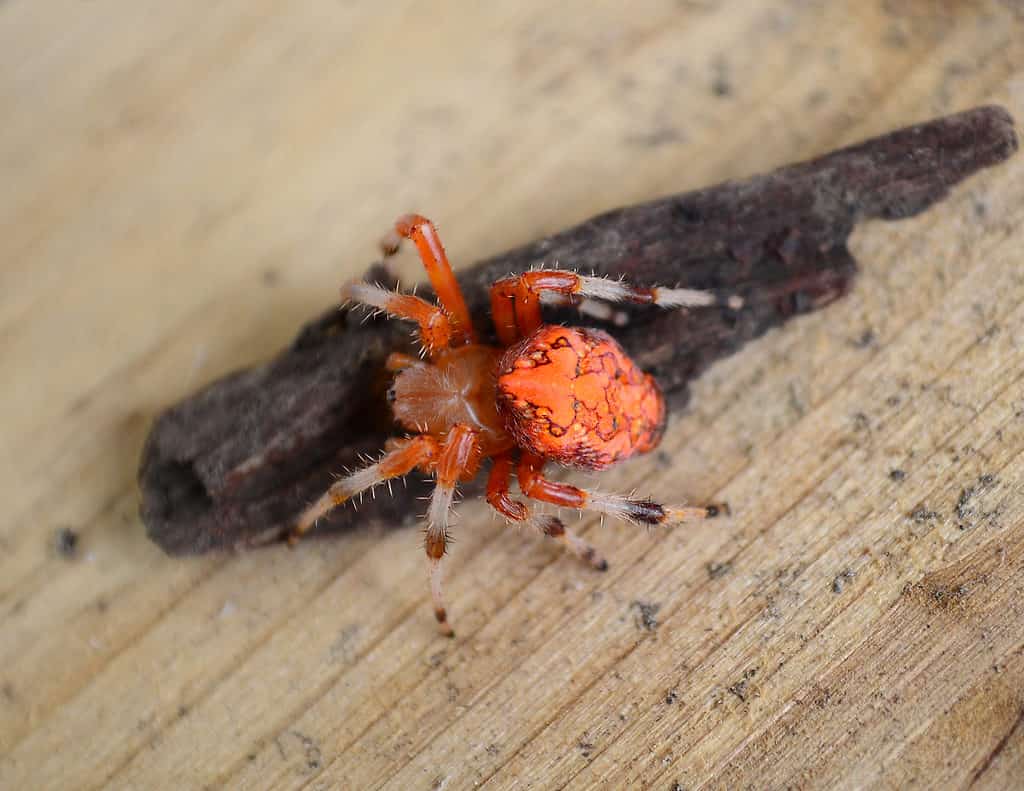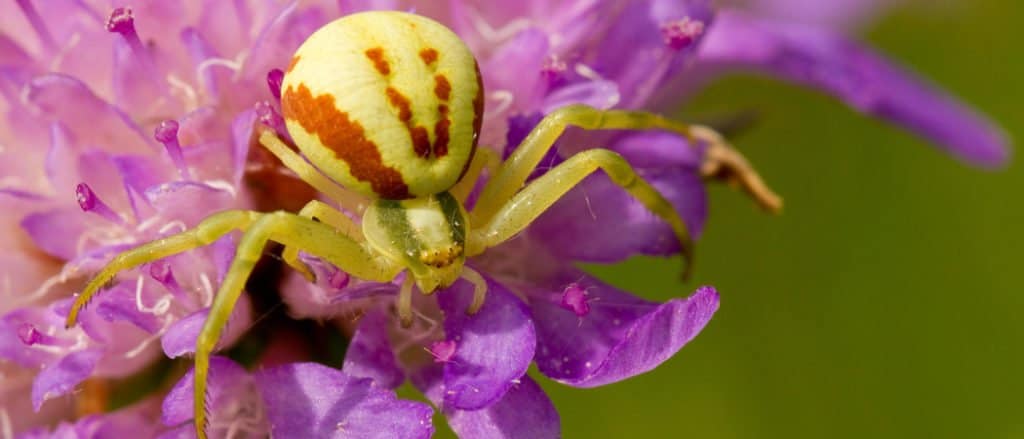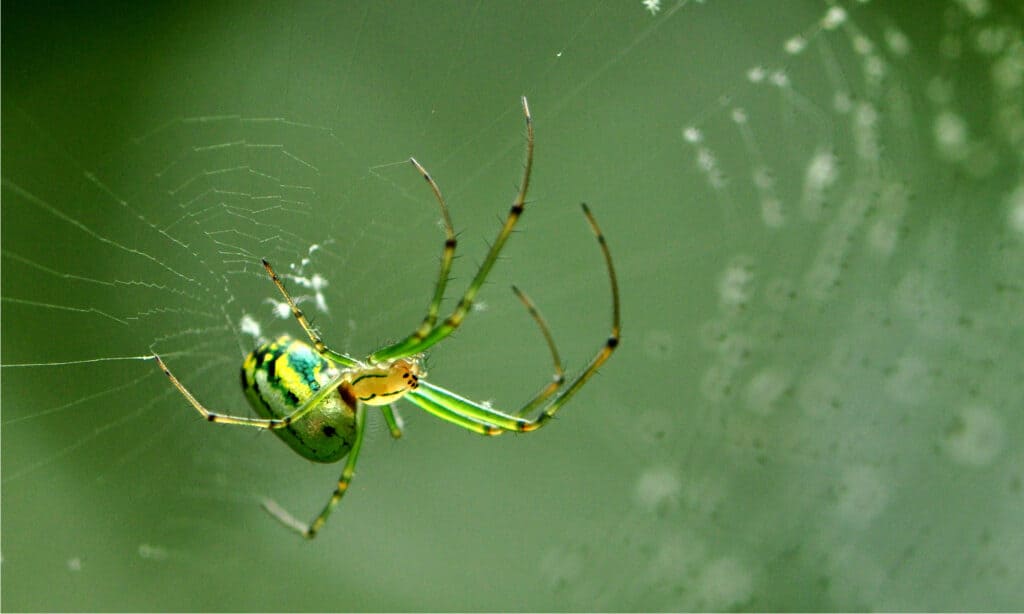Did you know the United States is home to over 3,000 spider species? Some of them have stunning colors and patterns that catch our eye. In this article, we’ll explore seven of the most colorful spiders found in the country, learning about their unique appearances, habitats, and behaviors.
While spiders might make some people feel uneasy, they’re crucial to our ecosystem. They help control insect populations and are prey to other animals. So, it’s essential to appreciate these eight-legged creatures for the work they do in our world.
In the spider world, color has many uses. It can help critters blend in, attract prey, or send messages to potential mates.
Get ready to be amazed by the beauty and creativity of these tiny wonders! Let’s dive into the world of the seven most vibrant and colorful spiders in the U.S. We’ll explore their fascinating looks, preferred homes, and interesting behaviors.
#1: Peacock Spider (Maratus volans)

Originally hailing from Australia, the peacock spider prefers various habitats, such as grasslands, shrublands, and forests.
©2,048 × 1,367 pixels, file size: 1.88 MB, MIME type: image/jpeg – License
Let’s kick off our colorful journey with the Maratus volans, better known as the peacock spider. This tiny yet mesmerizing creature is famous for its vibrant colors and intricate patterns. They are not native to the U.S., but people have seen a few here. They certainly capture the hearts of spider enthusiasts.
The Peacock Spider’s Home
Originally hailing from Australia, the peacock spider prefers various habitats, such as grasslands, shrublands, and forests. Their small size, measuring only around 0.2 inches, makes it easy for them to navigate through their environment and remain hidden from predators.
Unique Color Patterns
The male peacock spider boasts vibrant colors and iridescent patterns on its fan-like abdomen flaps. These dazzling hues and designs not only make them visually stunning but also play a significant role in their mating rituals.
Behaviors
The peacock spider’s behavior is as fascinating as its appearance. This tiny arachnid is known for its intricate and captivating courtship dance, which showcases not only its vibrant colors but also its agility and creativity.
- A dazzling display. When it’s time to attract a mate, the male spider puts on a spectacular courtship display. He raises his abdomen, fans out his flaps, and dances to impress the female. This show of colors and movement is truly a sight to behold.
- Clever hunters. Despite their small size, peacock spiders are skilled predators. They primarily feed on insects and use their exceptional jumping abilities to catch their prey. With acute eyesight and precise movements, these tiny spiders are efficient hunters in their tiny world.
#2: Black and Yellow Garden Spider (Argiope aurantia)

The vivid black and yellow markings on the abdomen of this spider serve several purposes.
©iStock.com/AwakenedEye
Next on our list of colorful spiders is the black and yellow garden spider. As the name suggests, this striking spider features bold black and yellow markings on the abdomen, making it an eye-catching presence in gardens across the U.S.
Where the Garden Spider Lives
The spider thrives in various habitats, including gardens, meadows, and fields. They reside throughout the contiguous U.S. and are often hanging on their large, orb-shaped webs that they build close to the ground among tall plants.
Unique Color Patterns
The vivid black and yellow markings on the abdomen of this spider serve several purposes. First, these colors act as a warning to potential predators, signaling that they might be toxic or unpalatable. Additionally, the bright colors can help to attract prey, such as insects, to their webs.
Behaviors
The spider is not just a visual marvel but also an intriguing creature when it comes to its behavior. This striking spider exhibits fascinating web-spinning techniques and distinct patterns of movement.
- Web construction. Black and yellow garden spiders have impressive web-building abilities. They create large, orb-shaped webs with a unique zig-zag pattern, called a stabilimentum, in the center. However, scientists still debate the purpose of this pattern, with some suggesting it provides structural support, while others believe it attracts prey or deters predators.
- The waiting game. These spiders are ambush predators, patiently waiting for prey to become ensnared in their webs. Once caught, they quickly immobilize their prey with venom and wrap it in silk before consuming it later.
#3: Marbled Orb Weaver (Araneus marmoreus)

The marbled
orb weaver
‘s beauty lies in the remarkable patterns adorning its abdomen. Ranging from vivid oranges and yellows to creamy whites.
©iStock.com/earlydawnphotography
This stunning spider showcases a kaleidoscope of colors and intricate patterns on its abdomen, making it a true visual delight among its eight-legged peers.
The Marbled Orb Weaver’s Habitat
The marbled orb weaver can be found across the U.S. in various habitats, such as forests, meadows, and even your backyard garden. They thrive in areas with abundant vegetation, where they can build their signature orb-shaped webs.
Unique Color Patterns
The marbled orb weaver’s beauty lies in the remarkable patterns adorning its abdomen. Ranging from vivid oranges and yellows to creamy whites, these colors intermingle with intricate markings resembling marbled stone. The combination creates a mesmerizing display that sets this spider apart.
Behaviors
The marbled orb weaver is a visual delight, but its captivating behaviors are equally worthy of attention. This stunning spider demonstrates remarkable web-building skills and distinctive hunting strategies that showcase its adaptability and prowess.
- Masterful web builders. Like other orb weavers, the marbled orb weaver is a skilled architect, constructing large, circular webs to catch prey. They often rebuild their webs daily, ensuring a fresh and sticky trap for unsuspecting insects.
- The art of camouflage. The marbled orb weaver’s vibrant colors and patterns aren’t just for show. They also serve as a form of camouflage, allowing the spider to blend in with its surroundings as it hides from predators and patiently waits for prey.
#4: Bold Jumping Spider (Phidippus audax)

Its most eye-catching feature is the iridescent green-blue chelicerae (fangs), which add a touch of shimmer and shine to this daring creature.
©Sari ONeal/Shutterstock.com
This spider may be small in size, but it makes up for it with its striking appearance and fearless personality. With an attractive combination of black, white, and iridescent green-blue coloration, this spider is a visual treat.
Bold Jumping Spider’s Preferred Environments
These little jumpers can be found throughout the U.S., inhabiting a wide range of habitats such as forests, grasslands, and even our homes and gardens. So naturally, they prefer areas with plenty of surfaces for them to leap across in search of prey.
Unique Color Patterns
The bold jumping spider sports a glossy black body, often adorned with white markings on its abdomen and legs. Its most eye-catching feature, however, is the iridescent green-blue chelicerae (fangs), which add a touch of shimmer and shine to this daring creature.
Behaviors
The bold jumping spider is not only a colorful wonder but also a fascinating creature in terms of its behavior. This energetic arachnid is known for its remarkable jumping abilities, keen eyesight, and curious nature, which make it a captivating subject to observe.
- Leaps and bounds. As their name suggests, bold jumping spiders are exceptional jumpers. They use their powerful legs to leap great distances in pursuit of prey, relying on their keen eyesight to calculate and execute precise jumps.
- Hunting tactics. These spiders don’t construct webs to catch prey. Instead, they actively hunt down insects, pouncing on them with incredible speed and accuracy. They use a silk tether as a safety line, ensuring they can quickly return to their original position if a jump goes awry.
#5: Goldenrod Crab Spider (Misumena vatia)

Goldenrod crab spiders have the incredible ability to change their body color to match their surroundings.
©Radka Palenikova/Shutterstock.com
Welcome the Misumena vatia, more commonly known as the goldenrod crab spider. This intriguing arachnid is a master of disguise, using its unique color-changing abilities and crab-like appearance to blend seamlessly with its environment.
Goldenrod Crab Spider’s Natural Settings
These crafty spiders can be found across the U.S. in various habitats, including meadows, fields, and gardens. They are particularly drawn to areas with an abundance of flowering plants, where they can hide and wait for unsuspecting prey.
Unique Color Patterns
Goldenrod crab spiders have the incredible ability to change their body color to match their surroundings. They can vary between white and bright yellow, depending on the flowers they inhabit. This color-changing talent allows them to remain hidden from both predators and prey.
Behaviors
The goldenrod crab spider’s captivating color-changing abilities are just the beginning when it comes to its intriguing behavior. This master of disguise also exhibits unique hunting strategies and remarkable adaptability to its surroundings.
- The art of camouflage. These spiders are true masters of disguise. They position themselves on flowers, patiently waiting for insects to land nearby. Once their prey is within reach, they quickly seize it with their long front legs, which resemble crab claws.
- Color-changing process. The color-changing process of goldenrod crab spiders is a slow and gradual one. It can take several days for the spider to fully change its color to match its environment, but the result is a near-perfect camouflage.
#6: Spiny-Backed Orb Weaver (Gasteracantha cancriformis)

This unique arachnid is sure to leave a lasting impression on anyone who encounters it.
©iStock.com/Weber
The spiny-backed orb weaver is a remarkable spider that boasts an eye-catching combination of vibrant colors and distinctive spines. This unique arachnid is sure to leave a lasting impression on anyone who encounters it.
Spiny-Backed Orb Weaver’s Preferred Habitats
These intriguing spiders can be found across the Southern United States, making their homes in a variety of environments, including forests, gardens, and wooded areas. They thrive in locations with plenty of trees and shrubs, which provide the perfect setting for their impressive webs.
Unique Color Patterns
The spiny-backed orb weaver features a bright, colorful abdomen with contrasting spots and six prominent spines protruding from its edges. The colors can range from bright red, orange, or yellow to stark white, making this spider a true standout among its peers.
Behaviors
The spiny-backed orb weaver’s bold appearance is just one aspect of its fascinating nature. This remarkable spider displays a range of captivating behaviors, from its intricate web-building skills to its defensive tactics that demonstrate its adaptability and resilience. Let’s explore the intriguing world of the Spiny-backed orb weaver:
- Skilled web spinners. Spiny-backed orb weavers create large, orb-shaped webs, often incorporating their characteristic spines into the design. These elaborate structures serve as both a means to capture prey and a deterrent to potential predators, who may find the spider’s appearance intimidating.
- Defensive display. When threatened, the spiny-backed orb weaver relies on its distinctive appearance to deter predators. The bold coloration and sharp spines send a clear message to potential attackers that this spider is not to be trifled with.
#7: Orchard Orb Weaver (Leucauge venusta)

Displaying a striking combination of green, silver, and yellow hues, this spider appears to shimmer in the sunlight.
©Shelly Jefferson Morton/Shutterstock.com
The orchard orb weaver is a true gem among spiders with its dazzling colors and shimmering, delicate appearance. With its slender body and metallic hues, this spider adds a touch of elegance to our list of colorful spiders.
Where the Orchard Orb Weaver Resides
You can find the orchard orb weaver throughout the United States, typically in orchards, gardens, and wooded areas. In fact, they are drawn to locations with an abundance of trees and plants, providing plenty of opportunities for them to build their stunning webs.
Unique Color Patterns
The orchard orb weaver’s beauty lies in its iridescent, metallic nature. Plus, it displays a striking combination of green, silver, and yellow hues. Additionally, this spider appears to shimmer in the sunlight, captivating onlookers with its ethereal presence.
Behaviors
The ethereal beauty of the orchard orb weaver is matched by its fascinating behaviors. This elegant spider showcases exceptional web-building techniques and a unique diurnal lifestyle that sets it apart from many other orb weavers. Let’s take a closer look at the captivating activities and habits of this stunning arachnid:
- Graceful web builders. Orchard orb weavers are known for their horizontal, orb-shaped webs. And these finely spun structures are often found in trees or shrubs, where the spider can easily capture flying insects as they navigate through the vegetation.
- Daytime dwellers. Unlike many other orb weavers, the orchard orb weaver is a diurnal creature, meaning it is active during the day. Because of its daytime activity, the spider can take full advantage of its stunning, sun-catching coloration.
Key Takeaways
We hope you enjoyed exploring the diverse world of the seven most colorful spiders found in the U.S. From the dazzling peacock spider to the intriguing goldenrod crab spider, these tiny creatures prove that beauty can be found in even the smallest of packages.
This journey through the vibrant world of spiders should inspire us all to appreciate their diversity and the roles they play in our ecosystem. As you’ve seen, spiders come in all shapes, sizes, and colors, each with its unique habits and characteristics.
We hope this colorful adventure has sparked your curiosity and inspired you to learn more about these fascinating creatures. The world of spiders is vast, and there’s always more to discover. So, whether you come across a brilliantly colored spider in your backyard or venture out into nature, remember to appreciate the intricate beauty and incredible adaptability of these eight-legged wonders.
The photo featured at the top of this post is © Alen thien/Shutterstock.com
Thank you for reading! Have some feedback for us? Contact the AZ Animals editorial team.






